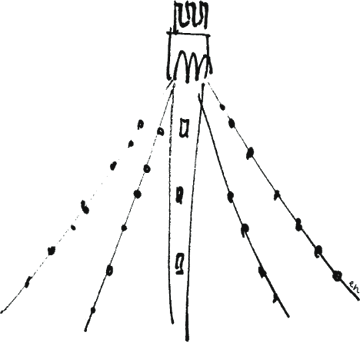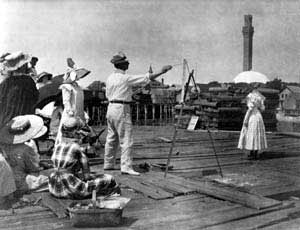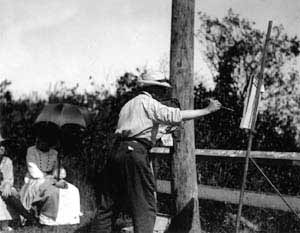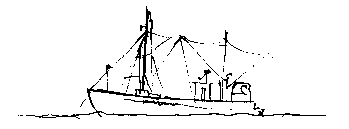 I am Provincetown.com ~ Ptown: An Extraordinary Place with Extraordinary People
I am Provincetown.com ~ Ptown: An Extraordinary Place with Extraordinary People
Provincetown Calendar of Events: What, When, Where ![]()
![]() A picture is worth a thousand words...
A picture is worth a thousand words...
|
Home | People | Provincetown Birthdays | Places | Favorites | Beaches | Events | Art | History | . . . . . . . . . . . . . . . . . . . . . . . . . . . . . . . . . . . . . . . . . . . . . . . . . . . . . . . . . . . . |
 |
The arrival of the railroad in 1873 made Provincetown accessible to both tourists and artists. Attracted by the incredible light and colorful surroundings, painters could stay in inexpensive boarding houses and rent studios for $50 per year.
-----
The Provincetown art colony came into being when Charles Webster Hawthorne opened his Cape Cod School of Art in the summer of 1899. By 1915 as many as 90 students were enrolled to learn his style of impressionist painting en plein air. (more about Cape Cod School of Art)
-----
E. Ambrose Webster, who had studied the later work of Monet, opened his Summer School of Painting in 1900. A pioneer of Modernism on the Outer Cape, he taught an advanced approach to color.
-----
In 1914 the Provincetown Art Association was founded. Business and professional people from the community as well as established artists provided the initial leadership. Hawthorne, Webster and William Halsall were among the first honorary vice presidents. The first annual exhibition was held in the summer of 1915. (more about PAAM)
-----
On August 27, 1916, a Boston Globe headline read "Biggest Art Colony in the World at Provincetown." More than 300 artists and students were in town (25 year-round) and six schools of art were in operation. Expatriate artists who had been studying and working in France returned, fleeing the war.
-----
At the same time there was an influx of poets, novelists, journalists and playwrights as well as artists from Greenwich Village, who brought with them a bohemian lifestyle. A group of radical writers, actors and artists that became known as The Provincetown Players produced plays on Lewis Wharf in the East End. Eugene O'Neil's breakthrough drama "Bound East For Cardiff" was first staged there.
-----
Six artists formed the Provincetown Printers in 1915, developing a unique method of woodcut printing, making single block or "white line" prints. The method lent itself to personal cubist styles soon developed by Agnes Weinrich and Blanche Lazzell. By 1918 the enlarged group established a gallery on the site of the present Post Office and sent traveling shows through the United States, Canada and Europe.
-----
The Armory Show of 1913 introduced Modernism to the American public and made visible growing rifts in the art world. The Provincetown Painting Classes, begun by Ross Moffett and Heinrich Pfeiffer in the '20s, were Modernist in approach. By 1925, Moffett, Karl Knaths and other artists were fighting conservatism within the art community and, beginning in 1927, the Art Association held a separate Modernist show each year.
-----
In the '30s, Henry Hensche opened his Cape School of Art. Hensche taught in Provincetown for more than 55 years, continuing plein air demonstrations and many other Hawthorne traditions. (more about Cape School of Art)
-----
In 1935 Hans Hofmann opened his Summer School of Art. Famed as a teacher of abstract modernism, Hofmann taught and painted here for 30 years while also maintaining his New York school in the winter. His classes grew large in the post-war years with the influx of students enrolled under the GI Bill, and artists of all styles crowded into his Friday critiques. (more about Hans Hofmass as a teacher)
-----
The Depression years of the '30s were difficult for everyone, although federal WPA programs provided some support for artists, especially year-rounders. During World War II the town was blacked-out; artists and townspeople were away serving in the military or working in defense plants. Art activity was very limited although the Surrealists Roberto Matta, Arshile Gorky and Max Ernst arrived around this time,as did Robert Motherwell and the noted patrons and collectors Ione and Hudson Walker.
-----
In 1937 the first combined exhibition of work by modernists and 'regulars' was held at the Art Association; by then it was hard to distinguish between them.
-----
From the '40s to the '50s, Provincetown was a summer center of Abstract Expressionism represented by such painters as Franz Kline, Jackson Pollock, Lee Krasner, Motherwell, Helen Frankenthaler and Fritz Bultman, in addition to Hofmann.
-----
Forum 49 was a summer-long series of sophisticated programs held in 1949, beginning with the forum "What Is An Artist?" and ending with the controversial "French Art vs American Art Today." Record crowds attended the exhibits of paintings and programs focused on the avant garde in many areas (architecture, psychoanalysis, poetry, jazz) all held in a gallery at 200 Commercial Street.
-----
Galleries of high quality proliferated in the '50s and '60s. Artists' cooperatives were established and branches of New York galleries opened on Commercial Street.
-----
The Chrysler Museum opened in 1958 showing works from almost every period of art history and presenting the latest in contemporary art. Chrysler collected local art, encouraging more young artists, collectors and galleries to come to town. (more about Chrysler Museum)
-----
When the Art Association celebrated its Golden Anniversary in 1964, it gained national attention with an exhibition tracing the history of Provincetown as an art colony.
-----
In 1970 a forum was held at the Association asking "What Is Happening to Our Art Colony?" What had been the summer art colony now seemed overcrowded and tourist-oriented and the few studios remaining rented for as much as $1,500 for the season.
-----
The Fine Arts Work Center, which had opened in 1968, moved into its permanent quarters in 1972. Its goal was "to give young writers and visual artists the chance to live on their own and work...bringing new blood into the community and encouraging artists to settle there." (more about Fine Arts Work Center)
-----
The Town purchased the former Chrysler Museum in 1976, creating the Provincetown Heritage Museum to preserve and present historical artifacts including the Town's large collection of paintings by local artists. (Today Provincetown Public Library)
-----
The significance of Provincetown's role as an art colony was documented with the publication in 1977 of Dorothy Seckler's Provincetown Painters 1890's-1970's by the Everson Museum of Art in Syracuse, New York and an exhibition shown at both the Everson and the Provincetown Art Association.
-----
With the hope of enlivening the local art scene, the Long Point Gallery was opened in 1977 by a group of established artists, most of whom had studios and galleries in New York. Their cooperative gallery functioned until 1998 when the building was sold.
-----
In 1979 the first annual Fall Arts Festival was held, a tradition which continues today. Special events, performances and exhibitions are scheduled along with open houses in artists' studios.
-----
In 1985 Ray Elman and Christopher Busa (son of late abstract painter Peter Busa) published the first issue of Provincetown Arts. It is an annual publication now averaging almost 200 pages "focusing broadly on the artists and writers who inhabit or visit the tip of Cape Cod."
-----
In May 1992 the Berta Walker Gallery opened an exhibition entitled "Generations in the Arts: Provincetown." On display was work by artists from families having two or more generations in the arts who were born or worked in Provincetown. Thirty-two families were represented.
-----
In 1999 the Town celebrated its centennial as an art colony with major shows of work by Provincetown's masters of the past at the Art Association, Fine Arts Work Center, Pilgrim Monument Museum and local galleries, as well as special programs of drama, poetry, photography and cinema. The Art Association held Forum 99, a series of performances and panel discussions similar to those of Forum 49.
-----
The Provincetown International Art Institute, a part of Campus Provincetown, enrolled its first students in Fall 1999. Based at the Herman and Mary Robinson Museum School of the Art Association and at Provincetown High School, professional artists teach courses in the visual arts, accredited through Cape Cod Community College. (Today the school is folded into Provincetown Art Association and Museum.)
-----
Since Charles Hawthorne's arrival in 1899, the Provincetown art colony has played a significant role in the history of American art -- often in the forefront. A microcosm of the larger art world, Provincetown has both welcomed and resisted new art movements. Today there is no one dominant teacher or school or style of art. In Provincetown, as elsewhere, pluralism is the mode. At the beginning of a new century, both established and emerging artists feel free to seek their own form of expression.
from PROVINCETOWN: THE ART COLONY A Brief History and Guide by Nyla Ahrens, published by Provincetown Art Association and Museum, 1997. Revised edition published 2000. Available in print at Provincetown Art Association and Museum Store.
© Nyla Ahrens
![]()
Pin it!
. . . . . . .

Hawthorne teaching on the pier; Pilgrim Monument and Provincetown Town Hall in the background.

E. Ambrose Webster demonstrating to a class on Bradford Street across from his house, 1916. Photographer: A.J. Philpott, PAAM Archives, from glass plate negatives donated by Stephen Borkowski


If I can say "I am Provincetown" so can YOU :)
. . . . . . . . . . . . . .
© Since 2000. All rights reserved.